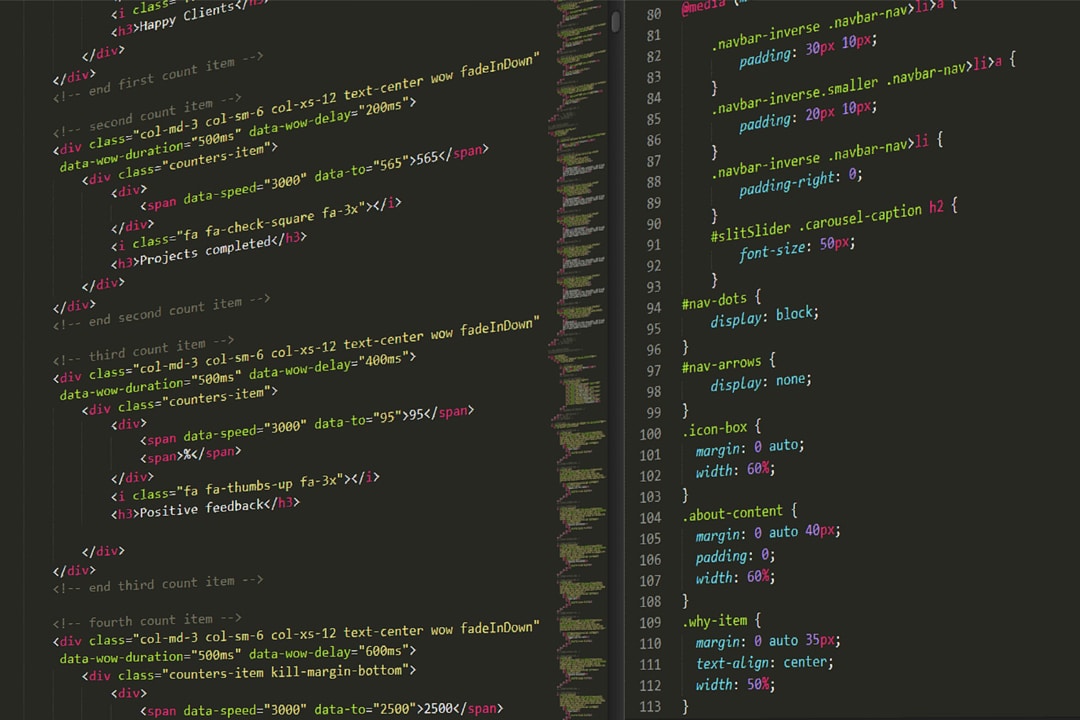
Javascript, CSS and HTML are different components that make up a website. They each provide a structure, the look and all the functionality on your website that visitors love. In the past, only HTML was used. You may recognize the simplistic websites from those days. Javascript and CSS allow you to create much more modern and elaborate websites today. The three components complement each other well and are actually indispensable to all current websites on the Internet.
What are the differences?
Despite the fact that CSS, HTML and Javascript complement each other well, all three are distinct applications. For each website component you will read a brief description below, including an explanation of how this particular program works.
What is CSS?
CSS stands for Cascading Style Sheets and specifies how the HTML of your website is displayed. So CSS is about the formatting or layout on your website. To represent formatting and layout, selectors and declarations are used to shape all elements. CSS3 is the most important version.
How does CSS work?
So CSS makes your website look beautiful. CSS does this by supplementing the HTML files of your website. This is also called granting declarations. For this, CSS is not covered by the <html> or <head> tags, but under the <style> tags.
The body, title, and all paragraphs of your website get different declarations. This allows you to choose a position, color, font or font size for each item.
What is HTML?
HTML stands for Hyper Text Markup Language and is best described as the standard “layout” for your website. HTML lays the foundation or foundation for your website, so to speak, from which programs like CSS can later make beautiful things. With HTML, you build your website using various tags and building blocks. The latest version of HTML is HTML5.
How does HTML work?
So the basic structures of your website are built through HTML. You don’t have any layout or functionality yet, but compare it to your own home: you won’t be able to hang a painting without having a wall upright. The HTML of your website is built with different tags, as we mentioned above with CSS.
The very first tags you’ll encounter are the <doctype html> tags, which indicate that the website is built using HTML. Next, you’ll see that all parts of your website are designed with tags. A distinction is made between the <body> and the <head> tags. These respectively take care of the information displayed on the website and the underlying processes, script or applications that visitors do not need to see.
A sample website in HTML always looks very bleak, but that’s where CSS and Javascript come in. This allows you to give the HTML version a nicer shape.
What is Javascript?
Javascript is a programming language that you can use to make your websites dynamic. When you use HTML, you only set up the foundation and with CSS you make HTML a little more attractive, but then you still have a static website that you can’t do much with. This is where Javascript comes in: the programming language makes your website dynamic by having things calculated, validated or further interactive. This completes the front-end view of your website.
How does JS work?
Within your website’s tags, Javascript falls under scripts – but, given the name of the programming language, that may not come as a surprise. By programming with Javascript, you can make things interactive or have them change daily. For example, in the script tags you can enter the time or date live, which also changes every day. Would you do this without Javascript, you would have to manually update the code each day to the date of that day. Furthermore, Javascript can also predict your search queries, as you see on YouTube or Google, for example. You can even use Javascript to create games or display graphical things. The possibilities with Javascript are enormous.
Creating a website with HTML, CSS and Javascript
For simpler websites, HTML, CSS and Javascript will do just fine. These three front-end components of your website are basically sufficient to show a somewhat simpler website to your visitors in a beautiful and functional way. If you start working with a more complex or larger website, HTML, CSS and Javascript will no longer suffice.
Then you will also need to start working with back-end components for your website. Whereas HTML, CSS and Javascript as front-end components are immediately visible to your visitors, the back-end components are not. Think SQL, PHP, Python or many more. Combining front-end and back-end together creates what is known as a “full stack”, which supports your large website just fine. Nevertheless, HTML, CSS and Javascript together are fine if you want to run a somewhat smaller website, for example with mainly informative pages.
Conclusion: HTML, CSS and Javascript
HTML, CSS and Javascript allow you to determine to a large extent what visitors to your website will see. HTML provides the foundation of your website. CSS makes the base look a little more attractive. Javascript completes this by making your website dynamic and interactive. It is wise to build your website in this order as well. So start with HTML, and then build out to CSS and Javascript respectively. For each step, you can find comprehensive step-by-step plans on search engines like Google to beautifully design your website.
You should also read our blogs on iFrames and the embedding of YouTube videos. You probably also like our blog about what a frontend developer does is also interesting.